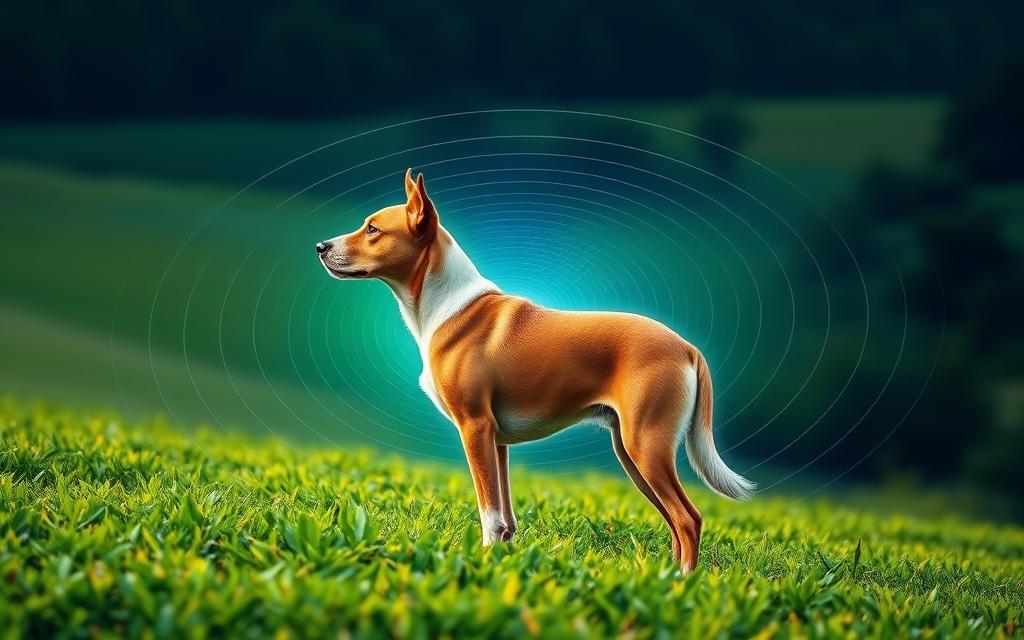
Did you know dogs use the Earth’s magnetic field for more than just finding their way home? They also align themselves along the north-south axis when they poop. A study in the journal Frontiers in Zoology found this out after watching 70 dogs of 37 breeds for two years.
Researchers recorded 1,893 poop and 5,582 pee events. They found that dogs prefer to poop and pee facing north-south when the magnetic field is calm. They avoid the east-west direction.
Key Takeaways
- Dogs show a clear preference for aligning themselves along the north-south axis when defecating and urinating.
- This behavior is seen only when the magnetic field is stable or “calm”. It disappears when the field is changing.
- The study suggests dogs can perceive and use the Earth’s magnetic field for orientation and navigation, not just for relieving themselves.
- The findings open up new avenues for research on how various organisms, including dogs, can detect and utilize the Earth’s magnetic field.
- The study highlights the need to consider magnetic field effects in future studies on animal behavior and navigation.
- Fascinating Discovery: Dogs Align with Earth's Magnetic Field
- Exploring Canine Magnetoreception
- Methodology: Observing Dog Behavior
- How Dogs Use Earth's Magnetic Field
- Axial Alignment During Defecation
- Impact of Magnetic Field Fluctuations
- Implications for Magnetoreception Research
- Revisiting Past Experiments
- Potential Applications in Biomedicine
- Conclusion
- FAQ
Fascinating Discovery: Dogs Align with Earth’s Magnetic Field
Recent research has shown how dogs use the Earth’s magnetic field for navigation. A study found that dogs prefer to align their bodies along the north-south axis when they go to the bathroom. This happens only when the magnetic field is calm.
The study followed 70 dogs in Germany and the Czech Republic for two years. The dogs wore GPS trackers, recording 1,893 defecations and 5,582 urinations. The results were interesting: dogs aligned their bodies along the north-south axis when the magnetic field was stable.
“The findings open new horizons for the study of how organisms, including animals, can use magnetic field for direction and for studies of magnetic fields produced by living organisms.”
This behavior shows that dogs might have a magnetic sense, like migratory birds. Scientists think that light-sensitive proteins called cryptochromes help dogs navigate. This could be a valuable compass for them.
This discovery is not just about dogs. It could help us understand how animals use the Earth’s magnetic field. It might also reveal how magnetoreception works in animals, including the radical pair hypothesis.
As research continues, scientists are excited to learn more about dogs’ navigation skills. They hope to find new uses for this knowledge in animal behavior and biomedicine.
Exploring Canine Magnetoreception
Dogs have an amazing sense of direction. They can find their way back home from far away. This has made scientists curious about their magnetic sense.
They think dogs might use the Earth’s magnetic field to navigate. Studying this could lead to new discoveries in magnetobiology. Dogs are great subjects for research because they can learn to follow different cues.
Investigating Dogs’ Extraordinary Orientation Abilities
Recent studies show dogs might have a magnetic sense. Researchers tracked 27 dogs from 10 breeds with GPS and cameras. They followed the dogs for three years and over 600 trips.
The dogs used two main ways to find their way: tracking and scouting. Tracking means following their path back, and scouting means exploring new areas. This shows their clever navigation skills.
Some dogs started their journey home with a “compass run.” They moved about 20 meters along the Earth’s magnetic field. This suggests they might be sensitive to magnetic cues, helping them find their way.
| Navigation Strategy | Percentage of Trips |
|---|---|
| Tracking (retracing outbound path) | 60% |
| Scouting (exploring new territory) | 30% |
| Combination of tracking and scouting | 8% |
This research is very important. It suggests dogs might have a magnetic sense for navigation. More studies could reveal how this sense works.
“Many dogs, like Cleo the yellow Labrador retriever, can travel significant distances back to their old homes, even across states or countries.”
As research goes on, finding out about dogs’ magnetoreception will be exciting. It could lead to new insights into animal navigation and their amazing abilities.
Methodology: Observing Dog Behavior
To learn more about how dogs navigate, researchers studied 70 dogs for two years. They watched as the dogs moved and found their way without leashes or walls. This helped them see how dogs use the Earth’s magnetic field.
The study let dogs roam freely. This allowed them to show their natural ability to sense the magnetic field. It was a chance to see how dogs use this sense without any outside help.
Meticulous Observations and Data Collection
The researchers paid close attention to the dogs’ movements. They watched how the dogs aligned when they defecated or urinated. This helped them understand how dogs use the Earth’s magnetic field and geomagnetic field navigation.
The study’s results showed how dogs use the cryptochrome hypothesis and radical pair mechanism. These are the ways dogs sense the magnetic field. This knowledge could lead to new discoveries in avian magnetoreception and the study of magnetically sensitive proteins.
This study gave us a lot of information on how dogs navigate. By watching 70 dogs for two years, researchers learned a lot. Their findings could help us understand dog migration patterns and animal magnetoreception better.
How Dogs Use Earth’s Magnetic Field
Research shows that dogs can sense and navigate using the Earth’s magnetic field. This discovery is exciting and opens up new areas of study. It helps us understand how animals use magnetic cues for direction and awareness.
A study with 70 dogs over two years found something interesting. Under calm magnetic field conditions, dogs preferred to excrete while aligned along the north-south axis. This was seen in 1,893 defecations and 5,582 urinations. It shows dogs can detect and respond to Earth’s magnetic fields.
“The findings open new horizons for research in the use of magnetic fields for direction finding and perhaps also in magnetically-induced alterations of physiological processes in living organisms.”
Scientists think dogs, like many animals, use a special mechanism to sense the magnetic field. This involves magnetically sensitive proteins called cryptochromes. This sense might help them migrate and navigate.
More research is needed to understand this canine magnetic sense. By studying how dogs use Earth’s magnetic field, we learn more about many species’ navigation.
Axial Alignment During Defecation
Recent studies have shown how dogs use the Earth’s magnetic field during defecation. They found that dogs show a significant north-south orientation when they excrete under stable magnetic conditions.
The study, published in the journal Frontiers in Zoology, observed 70 dogs over two years. It found that dogs align their bodies along the north-south axis when the magnetic field is calm.
But when the magnetic field conditions become unstable, dogs lose their alignment. This shows that canine magnetoreception is key in their geomagnetic field navigation and alignment during defecation.
| Magnetic Field Conditions | Dog Alignment Preference |
|---|---|
| Stable (0% change in declination) | Highly significant north-south orientation |
| Unstable (> 2% change in declination) | Random, no directional preference |
These findings help us understand dog magnetoreception better. They also show potential uses in biomedicine and navigation research. By studying the cryptochrome hypothesis and radical pair mechanism, scientists can learn more about this ability. This knowledge can help us understand animal migration patterns and behavior.
Impact of Magnetic Field Fluctuations
Researchers have found out how dogs use the Earth’s magnetic field for navigation. This is especially true for their elimination behaviors. But, they also discovered that this skill changes with magnetic field shifts.
Directional Preferences Abolished During Unstable Magnetic Field Changes
The study showed that as the Earth’s magnetic field changes, dogs’ body orientations get more random. When these changes are over 2%, dogs lose their directional preference.
Further research found that dogs’ body orientations change with magnetic field shifts. This was true whether looking at raw data or averages per dog.
This means dogs’ ability to align themselves along the north-south axis depends on the magnetic field’s stability. Large changes in the field make this ability disappear.
“The discovery of dogs’ sensitivity to changes in the magnetic field has opened new horizons in magneto-biological research, as highlighted by the scientists involved in the study.”
This research is exciting because it shows how dogs use the Earth’s magnetic field. It also helps us understand how other living things might use magnetic cues for navigation.
Implications for Magnetoreception Research
This study shows how dogs use Earth’s magnetic field for navigation and to find the right spot to defecate. It’s a big deal for magnetoreception research. For the first time, scientists have seen a clear reaction to Earth’s magnetic field changes in a mammal. This could make researchers rethink their past studies and observations.
Dogs prefer to poop along the north-south axis when the magnetic field is steady. This is really interesting. It means more animals might use the Earth’s magnetic field than we thought, not just birds.
The study’s results might also make scientists look again at how magnetic storms affect animals and people. This could help us understand more about how animals navigate and even how it affects our health.
| Parameter | Findings |
|---|---|
| Magnetoreception in Mammals | First demonstration of a “measurable, predictable behavioral reaction” to magnetic field fluctuations in a mammalian species |
| Implications for Behavior Science | Behavior scientists may need to revise previous experiments and observations to consider the role of magnetoreception |
| Potential Impact on Organisms | Biologists and physicians should reconsider the effects of magnetic storms on various organisms, including humans |
In conclusion, this study on dogs and magnetoreception could change how we study magnetoreception in the future. It could help us understand better how animals, including humans, use the Earth’s magnetic field.
Revisiting Past Experiments
Recent studies on dogs show they align with the Earth’s magnetic field. This makes us rethink past experiments. The magnetic field is calm only 20% of the day. This might explain why some studies didn’t get the same results.
Many animals, like songbirds and sea turtles, use the magnetic field for navigation. Even dogs and cats have this ability. These studies reveal how animals use the Earth’s magnetic field for important tasks.
Implications for Future Research
The studies on dogs highlight the need to consider the magnetic field in future research. This is especially true for studies on animal behavior and cognition. To get better results, researchers must account for the magnetic field’s changes.
| Animal | Magnetic Field Effect | Study |
|---|---|---|
| Monarch butterflies | Magnetic field effect on migratory behavior | A study published in the Journal of Experimental Biology |
| American cockroaches | Preference for four cardinal geomagnetic positions at rest | Research in the Journal of Comparative Physiology A |
| Zebrafish | Magnetosensation behavior | Findings in the journal PLOS ONE |
| Japanese eel | Magnetic sense as determined by conditioning and electrocardiography | Study in the Journal of Experimental Biology |
| Chum salmon | Magnetic compass orientation after internal and external field alterations | Research published in Animal Behaviour |
By understanding the Earth’s magnetic field’s impact, researchers can improve their studies. This will help us learn more about the amazing abilities of animals.
Potential Applications in Biomedicine
The discovery of magnetoreception in dogs is exciting. Dogs are easy to train and can help us learn more about this ability. This could lead to new discoveries in biomedicine.
Animal models have helped a lot in medical research. Over 90% of Nobel Prize-winning studies in Physiology or Medicine used them. Dogs have been used in many studies, including the first on gastric secretions and insulin.
| Statistic | Value |
|---|---|
| Percentage of Nobel Prize studies in Physiology or Medicine that utilized animal models | 90% |
| Number of Nobel Prize projects that employed animal models | 186 out of 222 |
| Percentage of animal species used in Nobel Prize projects that were rodents | 42% |
The discovery of dog magnetoreception is very promising. It could lead to big advances in neurobiology and sensory physiology. It might also help in making new diagnostic and therapeutic tools.
“The use of animals in scientific research has enabled the development and testing of drugs, vaccines, and surgical techniques applicable to human and veterinary medicine.”
With careful ethics and following guidelines, this discovery could bring new solutions in biomedicine. It could help both human and animal health.
Conclusion
A study by the Institute of Vertebrate Biology has revealed how dogs use the Earth’s magnetic field. They found that dogs prefer to align their bodies along the north-south axis when the magnetic field is stable. This was observed in 80 dogs from 37 different breeds.
The study involved over 1,800 defecation and 5,500 urination events. These findings challenge our understanding of canine magnetoreception. They also suggest new uses in biomedicine and studying animal migration patterns.
This research could change how we study dogs and their behavior. It shows the Earth’s magnetic field’s impact on living things. By studying dogs’ abilities, we might learn more about animal behavior and our world.











